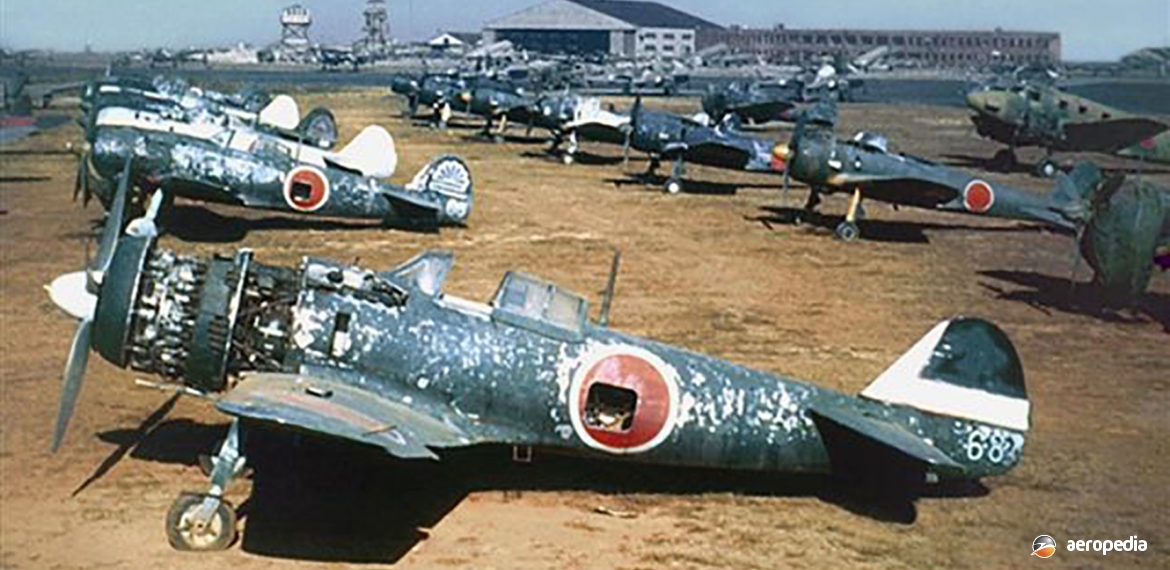Photograph:
Nakajima Ki.84 Hayate in Japan circa 1945 (USAF Museum)
Country of origin:
Japan
Description:
Single-seat fighter
Power Plant:
One 1,492 kw (2,000 hp) Nakajima (Ha-45-21) Army Type 4 Model 21 eighteen-cylinder two-row air-cooled radial engine
Specifications:
- Wingspan: 11.24 m (36 ft 2 in)
- Length: 9.92 m (32 ft 6½ in)
- Height: 3.38 m (11 ft 1 in)
- Wing area: 21.0 m² (226.04 sq ft)
- Max speed at sea level: 523 km/h (325 mph)
- Max speed at 6,500 m (21,325 ft): 624 km/h (388mph)
- Normal cruising speed at 6,000 m (19,685 ft): 380 km/h (236 mph)
- Stalling speed flaps down: 138 km/h (86 mph)
- Initial rate of climb: 1,155 m/min (3,790 ft/min)
- Service ceiling: 11,000 m (36,090 ft)
- Range with full internal fuel 697 litres (153 Imp gals) at 286 km/h (178 mph): 1,650 km (1,025 miles)
- Max range with two 200 litre (44 Imp gal) drop tanks at 278 km/h (173 mph): 2,920 km (1,815 miles)
- Empty weight: 2,660 kg (5,864 lb)
- Normal loaded weight: 3,716 kg (8,192 lb)
Armament:
Two fuselage mounted 13 mm (0.5 in) Ho-103 machine guns; two wing mounted 20 mm Ho-5 cannon; provision to carry up to two 250 kg (551 lb) bombs on underwing racks
History:
Work on the Ki.84 series commenced in early 1942, being aimed at eventually replacing the Ki.43 in Imperial Army service. The prototype was rolled out in March 1943 at Ojima airfield. The Ki.84 had a semi monocoque light-alloy flush riveted fuselage, the wing being of metal with fabric covered ailerons and hydraulically operated Fowler-type flaps. Initial power plant was the 1,343 kw (1,800 hp) Homare Ha-45-II. The first batch of aircraft laid down was 83 Ki.84s for service trials, these being supplied to the Tachikawa Air Arsenal.
A service trials unit was formed late in 1943 to operate the first 24 pre-production aircraft. Production took place at Nakajima’s Ota and Utsunomiya plants, the aircraft being built as the Army Type 4 Fighter Model 1A (Ki.84-1a). The Hayate (Hurricane), as it was known, was also built by Mansyu Hikoki Seizo KK (the Manchurian Aeroplane Manufacturing Co Ltd) at Harbin in Manchukuo. However, there were some delays in deliveries due to slow production and delivery of engines.
The Ki.84 series was able to be built at a faster rate than its predecessor, with Nakajima delivering 3,288 examples between April 1944 and mid August 1945, the Mansyu facility building 94 in 1945. However, problems were experienced with the lack of skilled workers, the Munitions Ministry drafting civilian employees to manufacturing plants without any consideration of their skills. This also resulted in problems with equipment installed in aircraft and production aircraft were not able to perform as well as the pre-production aircraft, which were basically hand made by skilled tradesmen.
The Ki.84 made its operational debut in China in August 1944, when aircraft of the 22nd Sentai took up duties at Hankow in support of a ground offensive by the Japanese Army. However, the unit was soon re-assigned to Leyte in the Philippines, being joined by the 52nd Sentai and others. Some eleven Sentais were equipped with the type during the defence of the Philippines and, although outnumbered by American fighters, they were able to give a good account of themselves, despite problems associated with inferior workmanship in their construction.
Units were formed for the defence of Japan. By the end of 1944, 1,670 had been delivered and some 16 Sentais of the Imperial Army were equipped with the fighter. Production switched from the initial Ki.84-I-ko to the Ki.84-I-otsu when the fuselage guns were replaced by 20 mm cannon. The Ki.84 was successful in the campaign against long-range Republic P-47 Thunderbolts and North American P-51 Mustangs and carrier-borne aircraft as the Allies approached the islands around Japan, but the Ha-45 engine did not have the necessary high-altitude performance to permit it to deal with much success against high flying Boeing B-29s bombing the homeland.
A development was a derivative known as the Ki.106, which was of wooden construction due to the increasing difficulties being experienced late in the war in Japan with having sufficient metals to continue production. Examples of this model were recovered from the Tachikawa Airfield in Japan and shipped to the United States for testing.
Two Ki.84-I-kos were captured by US forces at Clark Field, Manila. These were shipped to Australia where at least one was made airworthy and tested by the Technical Air Intelligence Unit of the South West Pacific Area at Eagle Farm, Brisbane, QLD. One of these (c/n 1446), which became S-17 and is thought to also have been XJ006 with the unit, was photographed flying around Brisbane, on one occasion in formation with a Supermarine Seafire III of the Royal Navy Pacific Fleet, a Grumman F6F-5 of the US Navy, and a North American P-51D Mustang of the USAAF. This machine was later shipped to the United States where it was tested at Wright Field, Ohio and later spent some time stored for the Smithsonian Institute. Later it spent some time in Canada. In 1963 it was again made airworthy (as N3385G) for movie work. It was placed on display at the Planes of Fame Museum in California until 1978 when it was shipped to the Tachiarai Peace Museum on the island of Kyushu, Japan.

